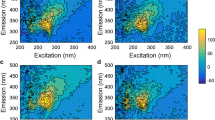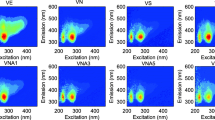Abstract
According to the different types and contents of amino acids in green tea, a new method was proposed for green tea classification and quality evaluation based on excitation-emission matrix (EEM) fluorescence spectroscopy coupled with multilinear pattern recognition in this work. Amino acids in green tea samples were first derived with formaldehyde and acetyl acetone solution. Derivatives of green teas were then scanned with a three-dimensional fluorescence spectrometry. Multilinear pattern recognition methods, including multilinear principal component analysis (M-PCA), self-weight alternative trilinear decomposition (SWATLD), and multilinear partial least squares discriminant analysis (N-PLS-DA) methods, were used to decompose the EEM data sets. All of these multilinear pattern recognition methods showed the clustering tendency for five different kinds of green tea. Compared with the other two methods, N-PLS-DA got more accurate and reliable classification result because it made full use of all the fluorescence information of the derivative green tea samples. At the same time, this method also revealed the possibility of evaluating the grade of green tea.







Similar content being viewed by others
References
Alcäzar A, Ballesteros O, Jurado JM, Pablos F, Martín MJ, Vilches JL, Navaloän A (2007) Differentiation of green, white, black, Oolong, and Pu-erh teas according to their free amino acids content. J Agric Food Chem 55:5960–5965
Bhattacharyya R, Tudu B, Das SC, Bhattacharyya N, Bandyopadhyay R, Pramanik P (2012) Classification of black tea liquor using cyclic voltammetry. J Food Eng 109:120–126
Bhondekar AP, Dhiman M, Sharma A, Bhakta A, Ganguli A, Bari SS, Vig R, Kapur P, Singla ML (2010) A novel iTongue for Indian black tea discrimination. Sensors Actuators B 148:601–609
Bro R, Kiers HAL (2003) A new efficient method for determining the number of components in PARAFAC models. J Chemom 17:274–286
Bro R, Smilde AK, De Jong S (2001) On the difference between low-rank and subspace approximation: improved model for multi-linear PLS regression. Chemom Intell Lab Syst 58:3–13
Chen ZP, Wu HL, Yu RQ (2001) On the self-weighted alternating trilinear decomposition algorithm-the property of being insensitive to excess factors used in calculation. J Chemom 15:439–453
Chen, QS., Zhao, JW., Fang, CH., & Wang, DM. (2007). Feasibility study on identification of green, black and Oolong teas using near-infrared reflectance spectroscopy based on support vector machine (SVM). Spectrochimica Acta Part
Chen QS, Guo ZM, Zhao JW (2008) Identification of green tea’s (Camellia sinensis (L.)) quality level according to measurement of main catechins and caffeine contents by HPLC and support vector classification pattern recognition. J Pharm Biomed Anal 48:1321–1325
Chen QS, Zhao JW, Lin H (2009) Study on discrimination of Roast green tea (Camellia sinensis L.) according to geographical origin by FT-NIR spectroscopy and supervised pattern recognition. Spectrochim Acta A 72:845–850
Chen QS, Zhang DL, Pan WX, Ouyang Q, Li HH, Urmila K, Zhao JW (2015) Recent developments of green analytical techniques in analysis of tea’s quality and nutrition. Trends Food Sci Technol 43:63–82
Cimpoiu C, Cristea VM, Hosu A, Sandru M, Seserman L (2011) Antioxidant activity prediction and classification of some teas using artificial neural networks. Food Chem 127:1323–1328
Cordella C, Moussa I, Martel AC, Sbirrazzuoli N, Lizzani-Cuvelier L (2002) Recent developments in food characterization and adulteration detection: technique-oriented perspectives. J Agric Food Chem 50:1751–1764
Devani MB, Shishoo CJ, Shah SA, Soni KP, Shah RS (1991) Localization of amino acids on thin-layer chromatograms with acetylacetone-formaldehyde reagent. J Chromatogr 537:494–496
Domínguez I, Doménech-Carbó A (2015) Screening and authentication of tea varieties based on microextraction-assisted voltammetry of microparticles. Sensors Actuators B 210:491–499
Dong YJ, Liu X, Mei L, Feng C, Yan CS, He SL (2014) LED-induced fluorescence system for tea classification and quality assessment. J Food Eng 137:95–100
Durante C, Bro R, Cocchi M (2011) A classification tool for N-way array based on SIMCA methodology. Chemom Intell Lab Syst 106:73–85
Esslinger S, Riedl J, Fauhl-Hassek C (2014) Potential and limitations of non-targeted fingerprinting for authentication of food in official control. Food Res Int 60:189–204
Fernández-Cáceres PL, Martín MJ, Pablos F, González AG (2001) Differentiation of tea (Camellia sinensis) varieties and their geographical origin according to their metal content. J Agric Food Chem 49:4775–4779
Gall GL, Colquhoun IJ, Defernez M (2004) Metabolite profiling using 1H NMR spectroscopy for quality assessment of green tea, Camellia sinensis (L.). J. Agric Food Chem 52:692–700
Goicoechea HC, Culzoni MJ, García MG, Galera MM (2011) Chemometric strategies for enhancing the chromatographic methodologies with second-order data analysis of compounds when peaks are overlapped. Talanta 83:1098–1107
Guimet F, Boque R, Ferre J (2006) Application of non-negative matrix factorization combined with Fisher’s linear discriminant analysis for classification of olive oil excitation-emission fluorescence spectra. Chemom Intell Lab Syst 81:94–106
He XY, Li JK, Zhao W, Liu R, Zhang L, Kong XH (2015) Chemical fingerprint analysis for quality control and identification of Ziyang green tea by HPLC. Food Chem 171:405–411
Hu LQ, Wu HL, Jiang JH, Han QJ, Xia AL, Yu RQ (2007) Estimating the chemical rank of three-way data arrays by a simple linear transform incorporating Monte Carlo simulation. Talanta 71:373–380
Huo DQ, Wu Y, Yang M, Fa HB, Luo XG, Hou CJ (2014) Discrimination of Chinese green tea according to varieties and grade levels using artificial nose and tongue based on colorimetric sensor arrays. Food Chem 145:639–645
Karoui R, Blecker C (2011) Fluorescence spectroscopy measurement for quality assessment of food systems—a review. Food Bioprocess Technol 4(3):364–386
Li XL, He Y (2008) Discriminating varieties of tea plant based on Vis/NIR spectral characteristics and using artificial neural networks. Biosyst Eng 99:313–321
Lin J, Zhang P, Pan ZQ, Xu HR, Luo YP, Wang XC (2013) Discrimination of oolong tea (Camellia sinensis) varieties based on feature extraction and selection from aromatic profiles analysed by HS-SPME/GC–MS. Food Chem 141:259–265
Mckenzie JS, Jurado JM, Pablos FD (2010) Characterisation of tea leaves according to their total mineral content by means of probabilistic neural networks. Food Chem 123:859–864
Mirasoli M, Gotti R, Fusco MD, Leoni A, Colliva C, Roda A (2014) Electronic nose and chiral-capillary electrophoresis in evaluation of the quality changes in commercial green tea leaves during a long-term storage. Talanta 129:32–38
Nilsson J, Jong SD, Smilde AK (1997) Multiway calibration in 3D QSAR. J Chemom 11:511–524
Obeidat SM, Al-Ktash MM, Al-Momani IF (2014) Study of fuel assessment and adulteration using EEMF and multiway PCA. Energy Fuel 28:4889–4894
Palacios-Morillo A, Alcázar A, Pablos FD, Jurado JM (2013) Differentiation of tea varieties using UV-Vis spectra and pattern recognition techniques. Spectrochim Acta A Mol Biomol Spectrosc 103:79–83
Pilgrim TS, Watling RJ, Grice K (2010) Application of trace element and stable isotope signatures to determine the provenance of tea (Camellia sinensis) samples. Food Chem 118:921–926
Pongsuwan W, Fukusaki E, Bamba T, Yonetani T, Yamahara T, Kobayashi A (2007) Prediction of Japanese green tea ranking by gas chromatography/mass spectrometry-based hydrophilic metabolite fingerprinting. J Agric Food Chem 55:231–236
Qin ZH, Pang XL, Chen D, Cheng H, Hu XS, Wu JH (2013) Evaluation of Chinese tea by the electronic nose and gas chromatography–mass spectrometry: correlation with sensory properties and classification according to grade level. Food Res Int 53:864–874
Reid ML, O’Donnell CP, Downey G (2006) Recent technological advances for the determination of food authenticity. Trends Food Sci Technol 17:344–353
Rezaei B, Khayamian T, Mokhtari A (2009) Simultaneous determination of codeine and noscapine by flow-injection chemiluminescence method using N-PLS regression. J Pharm Biomed Anal 49:234–239
Stodt U, Engelhardt UH (2013) Progress in the analysis of selected tea constituents over the past 20 years. Food Res Int 53:636–648
Tarachiwin L, Ute K, Kobayashi A, Fukusaki E (2007) 1H NMR based metabolic profiling in the evaluation of Japanese green tea quality. J Agric Food Chem 55:9330–9336
Yi T, Zhu L, Peng WL, He XC, Chen HL, Li J, Yu T, Liang ZT, Zhao ZZ, Chen HB (2015) Comparison of ten major constituents in seven types of processed tea using HPLC-DAD-MS followed by principal component and hierarchical cluster analysis. LWT-Food Science and Technology 62:194–201
Yu HC, Wang J, Xiao H, Liu M (2009) Quality grade identification of green tea using the eigenvalues of PCA based on the E-nose signals. Sensors Actuators B 140:378–382
Acknowledgements
The work was financially supported by Foundation of Henan University of Technology (grant no. 2014JCYJ08).
Author information
Authors and Affiliations
Corresponding author
Ethics declarations
Conflict of Interest
Leqian Hu declares that he has no conflict of interest. Chunling Yin declares that she has no conflict of interest.
Ethical Approval
This article does not contain any studies with human and animal subjects.
Informed Consent
Not applicable.
Rights and permissions
About this article
Cite this article
Hu, L., Yin, C. Development of a New Three-Dimensional Fluorescence Spectroscopy Method Coupling with Multilinear Pattern Recognition to Discriminate the Variety and Grade of Green Tea. Food Anal. Methods 10, 2281–2292 (2017). https://doi.org/10.1007/s12161-017-0798-1
Received:
Accepted:
Published:
Issue Date:
DOI: https://doi.org/10.1007/s12161-017-0798-1




